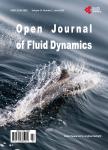Canary Greenhouse CFD Nocturnal Climate Simulation
Canary Greenhouse CFD Nocturnal Climate Simulation作者机构:Laboratoire de Recherche Scientifique et Pédagogique au Monde Méditerranéen CRMEF Meknès-Tafilalet Maroc Equipe de recherche en Energétique et Mécanique des Fluides ENSAM Meknès Maroc INRA Univ. Nice Sophia Antipolis CNRS UMR 1355-7254 Institut Sophia Agrobiotech Sophia Antipolis France Laboratoire de Thermodynamique et Energétique Faculté des Sciences Agadir Maroc
出 版 物:《Open Journal of Fluid Dynamics》 (流体动力学(英文))
年 卷 期:2016年第6卷第2期
页 面:88-100页
学科分类:07[理学] 0701[理学-数学] 070101[理学-基础数学]
主 题:Greenhouse CFD Airflow Microclimate Insect Screens
摘 要:The aim of this paper is to predict in details the distributed nocturnal climate inside a one hectare Moroccan canary type tomato-greenhouse equipped with continuous roof and sidewalls ventilation openings with fine insect screens, by means of 3D CFD (Computational Fluid Dynamics) simulations by using a commercial Software package CFD2000 based on the finite volumes method to solve the mass, momentum and energy conservation equations. The turbulent transfers were described by a k-ε model. Likewise, the dynamic influences of insect screens and tomato crop on airflow movement were modeled by means of the concept of porous medium with the Boussinesq assumption. Atmospheric radiations contribution was included in the model by customising the plastic roof cover temperature deducted from its energy balance. Also, the CFD code was customized in order to simulate in each element of the crop cover the sensible and latent heat exchanges between the greenhouse air and tomato crop. Simulations were carried out with a wind prevailing direction perpendicular to the roof openings (west-east direction). Simulations were later validated with respect to temperature and specific humidity field measurements inside the experimental greenhouse. Also, the model was verified respect to global sensible and latent heat transfers. Results show that, generally, greenhouse nocturnal climate distribution is homogeneous along the studies greenhouse area. The insect proof significantly reduced inside airflow wind speed. But there is no significant effect on the inside air temperature and specific humidity respect to outside.



